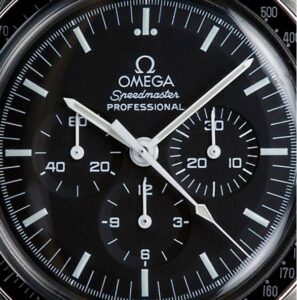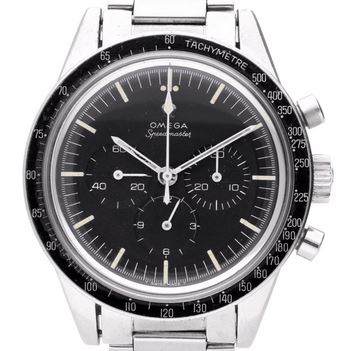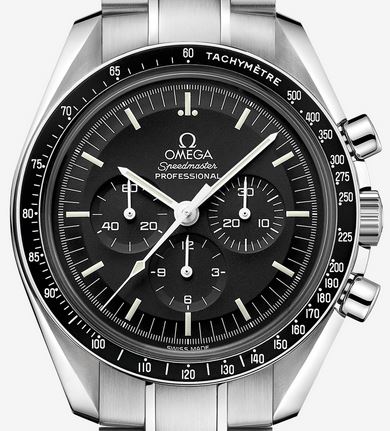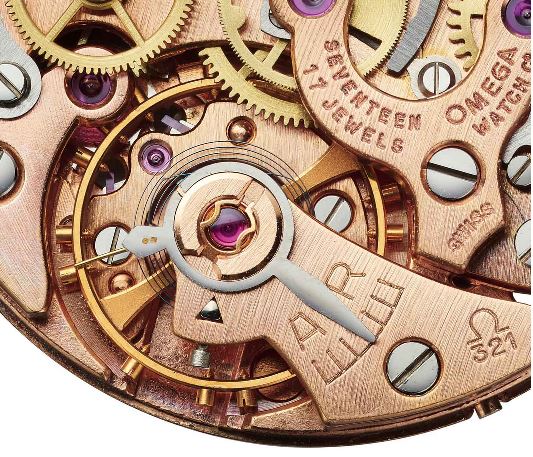The Omega Speedmaster, commonly known as the Moonwatch, has a long and fascinating history that dates back to the early days of space exploration. It is one of the most legendary and collectable watches in the world of horology. The Speedmaster was not originally designed for space exploration. Introduced in 1957 as part of a trilogy of tool watches, the Speedmaster was originally designed for car racers or anybody interested in measuring elapsed times with 1/5th of a second accuracy. It was the first chronograph of its kind to feature a tachymeter scale on the external bezel. It was designed to be a sturdy, precise, water-resistant watch that was reliable, legible and easy to manipulate. In this post, we will explore the history of the Omega Speedmaster and find out why it remains such an iconic timepiece.

The 1957 trilogy of “Master” watches
In 1957, Omega released three professional timepieces that would all go on to become absolute classics. There was the Seamaster 300 CK 2913 with waterproof properties for divers, the Railmaster CK 2914 with anti-magnetic properties for engineers, and the Speedmaster CK 2915 with stopwatch functionality for motorsports. The Omega Speedmaster arguably became the most famous of the three after it became the first watch on the moon in 1969 and became affectionately known as the Moonwatch (Omega at Chronopedia).
The Space Race
The Space Race was the Cold War rivalry between the United States and the Soviet Union during the 1950s and 1960s, aimed at achieving dominance in space exploration. It began with the Soviet Union’s launch of Sputnik 1 in 1957, the first artificial satellite, and escalated with Yuri Gagarin becoming the first human in space in 1961. These milestones spurred the U.S. to intensify its efforts, leading to the creation of NASA in 1958. Under President John F. Kennedy’s leadership, the U.S. declared its goal of landing a man on the Moon before the decade’s end, signalling a shift in the race.
The competition culminated in the 1969 Apollo 11 Moon landing, when Neil Armstrong and Buzz Aldrin became the first humans to walk on the lunar surface, marking a major victory for the United States. While the Space Race drove significant technological and scientific progress, it also symbolised the ideological rivalry of the Cold War. By the early 1970s, the competitive dynamic gave way to collaboration, as seen in the 1975 Apollo-Soyuz Test Project, paving the way for international cooperation in space exploration (Space Race timeline at Royal Museums Greenwich).
The Speedmaster in space
In 1964, NASA sent two employees out to secretly purchase five reputable chronographs to be tested for possible use in space. The Mercury program was almost complete, and the coming Gemini program with scheduled “space walks” would require a watch that could withstand the extreme conditions in space. The contenders were Rolex, Longines, Hamilton, Breitling and Omega. The tests involved exposing the watches to extremes of temperature, atmospheric pressure, shock, acceleration, vibrations, humidity and noise. However, after two rounds of tests, only one watch remained, the Omega Speedmaster.
Several years before Omega’s formal qualification for space flight, astronaut Walter Schirra wore his personal Omega Speedmaster (CK 2998) in space during his Mercury-Atlas 8 mission in October 1962.
Gemini program
On 23 March 1965, Gus Grissom and John Young wore officially qualified Speedmasters during the Gemini 3 mission. In June 1965, Ed White completed the first American spacewalk on Gemini 4 with a Speedmaster 105.003. It was subsequently selected and certified to become the official NASA wristwatch for EVA activities (Extravehicular activity – any activity done by an astronaut outside a spacecraft beyond the Earth’s atmosphere). Speedmasters were issued to all Gemini crews until the program’s conclusion in 1966 (Gemini at NASA).

Apollo program
In 1966, the Speedmaster 105.012 was updated to reference 145.012, both worn on the Moon by Apollo astronauts. These Speedmasters were used during early Apollo missions and reached the Moon with Apollo 11. Ironically, they are called “pre-Moon” Speedmasters since they predate the Moon landing and lack the later inscription. The inscription “The First Watch Worn on the Moon” was added to models produced after the landings. Neil Armstrong, the first man on the Moon, left his 105.012 Speedmaster in the lunar module as a backup timer. Buzz Aldrin wore his Speedmaster, making it the first watch worn on the Moon (Apollo 11 at NASA).
The Omega Speedmaster in space
The tachymeter on an Omega Speedmaster allows the wearer to measure speed based on time and distance. It works by timing how long it takes to cover a known distance and calculating speed using the scale. On Earth, this is useful for racing or other activities requiring precise speed measurements. In space, the tachymeter’s ability to measure elapsed time and calculate rates could assist astronauts with mission-critical tasks (Tachymeter bezel at SwissWatchExpo).
For astronauts, the Speedmaster provided a reliable way to measure time intervals when other instruments were unavailable or malfunctioning. The mechanical nature of the watch made it immune to issues like power failures, which could affect electronic systems. Timing specific events, like orbital manoeuvres or burn durations, could be crucial for mission success. During the Apollo 11 mission, the Speedmaster proved essential as a backup instrument. While it wasn’t explicitly used for navigation during the Moon landing, its reliability gave astronauts a reliable backup.
The Apollo 11 commander, Neil Armstrong, was the first man to set foot on the Moon. However, he left his Speedmaster Ref: 105.012 in the lunar module as a backup due to a timer malfunction. The second man on the Moon, Buzz Aldrin, wore his Speedmaster Ref: 105.012, making it the first watch worn on the lunar surface. The third member of the crew, Command Module Pilot Michael Collins, wore a Speedmaster Ref: 145.012, which was modified with larger and longer pushers. The ten astronauts who walked on the Moon during the six subsequent landings wore either Reference 105.012, 145.012, or 105.003. These three Speedmaster references remain the only ones to have accompanied man to the Moon. The one feature these virtually identical models have in common is the movement: the Calibre 321 (Space legacy at Omega).

Omega calibre 321
The Omega 321 is one of the most iconic and historically significant watch movements in watchmaking. Known for its precision and durability, it features a column-wheel chronograph mechanism, with measurements of 60 seconds, 30 minutes, and 12 hours, facilitated by a pillar wheel mechanism. This mechanism is more complex and considered superior compared to simpler lever-operated systems. Additionally, the movement’s robustness and reliability made it an ideal choice for aviation and space exploration.
Measuring 27.5 mm in diameter, the calibre 321 has a power reserve of approximately 44 hours and includes high-quality details such as a Breguet hairspring. Its design evolved from the Lemania CH27-12, a product of the collaboration between Omega and Lemania. The manual wind calibre 321 has 17 jewels, a frequency of 18,000 VPH and Incabloc shock protection. These features ensured the movement’s reputation as a high-performance and durable mechanism capable of handling extreme environments. According to EmmyWatch, the movement was produced between 1946 and 1968, with over 40,000 units manufactured during this period.

The 321 on manned missions
The calibre 321 holds a special place in history due to its role in the early Omega Speedmaster models. These Speedmasters, powered by the 321, were the first watches certified by NASA for manned space missions. They accompanied astronauts on critical missions, including Apollo 11, when humans first landed on the Moon. Its mechanical nature, unaffected by electromagnetic interference or the vacuum of space, made it the astronauts’ reliable choice.
Production of the Calibre 321 stopped in 1968. Later Speedmasters used different movements like the Calibre 861 and its successors. This has made watches featuring the original calibre 321 highly collectable and sought after by enthusiasts. Recognising its enduring appeal, Omega revived the movement in 2019. They used original blueprints combined with modern manufacturing techniques (Omega Speedmaster at Time and Watches).
Summary
The Omega Speedmaster Moonwatch is sought after by vintage watch collectors due to its history. The “Moonwatch,” was worn by Apollo astronauts during the Moon landing in 1969, making it a symbol of human achievement. Vintage Speedmaster models, especially those featuring the original calibre 321 movement, are prized for their craftsmanship, precision, and connection to one of the most significant moments in human history. Additionally, the Speedmaster’s design has remained largely consistent over the decades, with early models being rare and highly collectable. This combination of historical significance, technical excellence, and enduring appeal makes the Omega Speedmaster a coveted item for collectors.
Related content
Omega Speedmaster at Wikipedia.
Leave a Reply